As summer approaches and the days grow longer, we’re getting closer to a celestial event that marks the peak of the sun’s power: the summer solstice. You may have heard of it before, but did you know there’s so much more to this enchanting phenomenon? Celebrated on June 21st, this event has more history than you think. From its ancient origins and cultural celebrations to its astronomical significance and mystical traditions, we’ll uncover the secrets behind the longest day of the year. Get ready to be captivated by the wonders of the summer solstice!

Summer Solstice And Ancient Greek Culture
Summer Solstice marked the beginning of the Greek New Year according to the ancient Greek Calendars.

Not just the Greek New Year, but Summer Solstice also played a huge role in the history of the Olympic Games as it began a one-month countdown to start the Olympic games back then.
Summer Solstice And Chinese Culture
The Chinese saw Summer Solstice as another festival that was majorly associated with the divine feminine force better known as “yin”.

Summer Solstice in ancient China marked the festival that celebrated the “yin” force or the Feminine Force. Celebrations included worshipping Earth and paying respect to the Earth and the “yin” forces for nurturing them.
Summer Solstice And The “Protective Garlands” Of Herbs And Flowers
According to pagan folklore, there are certain superstitions associated with the Summer Solstice as well. They believe evil spirits are invited to the human realm on this day.

To avoid falling victim to the evil spirits, people were advised to wear “Protective Garlands” made of flowers and certain herbs to fend off evil spirits and keep people safe.
Summer Solstice From Egypt’s Sphinx
Many archeological findings have reported an association with Summer Solstice one way or the other. Take the infamous Sphinx, for example.

From the view of the Sphinx, the sun sets squarely between the Great Pyramids of Khufu and Khafre on Egypt’s Giza plateau on the summer solstice.
Summer Solstice And Some Modern Day Celebrations
Even in today’s age, several cultures have their own way of celebrating the Summer Solstice. For example, the popular European Midsummer Celebration.

During these festivities, girls dress up wearing flowers in their hair, and decorations that use garlands and leaves are found around in almost every household. Now you know what was the inspiration behind the infamous movie “Midsommar”!






